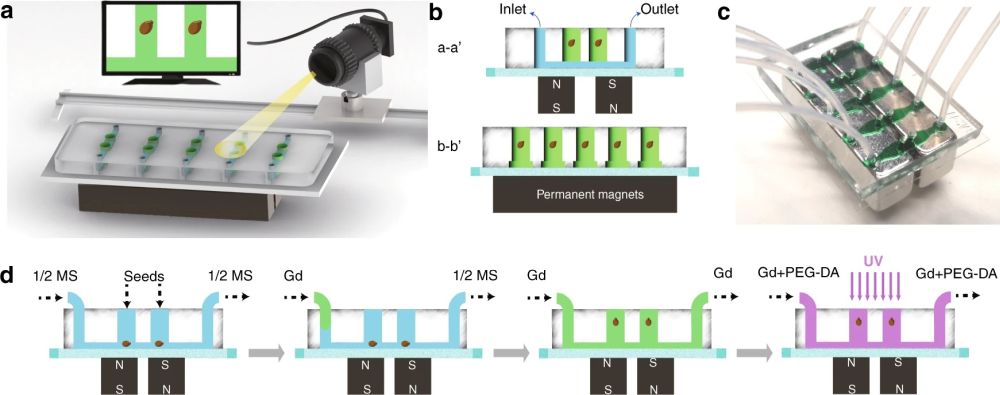
10 Feb Magnetically enabled simulation of microgravity on a microfluidic chip
Plants exhibit remarkable adaptability to their surroundings, constantly adjusting their growth and development in response to environmental cues. One of the most fundamental forces shaping plant behavior is gravity. But how do plants react when this constant force is altered or, in some cases, virtually eliminated? A groundbreaking study leverages the capabilities of a microfluidic platform to create a simulated microgravity environment, providing a unique window into the auxin responses of Arabidopsis seeds during early germination stages.
The study introduces a microfluidic negative magnetophoretic platform, ingeniously designed to levitate Arabidopsis seeds in an equilibrium plane, effectively counteracting gravitational acceleration. This simulated microgravity environment on a microfluidic chip provides a unique opportunity to observe and analyze plant responses in conditions that are challenging to achieve otherwise.
The microfluidic device, fabricated through soft lithography techniques, features parallel microchannels with cultivation reservoirs for seed levitation. This design not only enables the simultaneous operation of multiple seeds but also ensures a high-throughput and precise platform for conducting experiments. Permanent magnets strategically placed beneath the device generate the necessary magnetic field gradients, leading to the levitation of seeds and the creation of a simulated microgravity environment.

” On-site monitoring of Arabidopsis seeds by implementing a camera on a slide toward the microfluidic device. b Schematic of the microfluidic chip with five channels for seed cultivation. Each channel (10 mm in length, 2 mm in width, and 100 μm in height) has two cultivation reservoirs (1000 μm in diameter, 2 mm in depth) that are cut through the PDMS layer. c Photograph of the microfluidic negative magnetophoresis platform. Two permanent magnets are assembled beneath the glass substrate, and the inner edges are aligned to the cultivation reservoirs. d The experimental procedures. First, the seeds are put into the cultivation reservoirs, and the culture medium is injected into microchannels. Second, the culture medium was replaced by Gd3+ solution. Third, the seeds are lifted and maintained at the position by negative magnetophoresis. Finally, PEG-DA and Gd3+ solutions are injected into the channels and cured by ultraviolet radiation” Reproduced under Creative Commons Attribution 4.0 International License from Du, J., Zeng, L., Yu, Z. et al. A magnetically enabled simulation of microgravity represses the auxin response during early seed germination on a microfluidic platform. Microsyst Nanoeng 8, 11 (2022). https://doi.org/10.1038/s41378-021-00331-5
Auxin, a pivotal phytohormone in plant biology, regulates various aspects of plant growth and development. The study takes a deep dive into understanding how alterations in gravity impact the auxin response in Arabidopsis seeds. The findings reveal a significant repression of the auxin response in seeds subjected to simulated microgravity, shedding light on the intricate ways in which plants adapt to changes in their environment.
The researchers meticulously detail the experimental procedures, from the optimization of the device’s design based on finite element method (FEM) simulations to the use of gadolinium-based solutions for seed levitation. The article provides a comprehensive overview of the technical aspects and experimental insights, ensuring a thorough understanding of the study’s methodology and findings.
The microfluidic negative magnetophoretic platform presented in this study marks a significant advancement in the field of plant biology, offering a novel approach to simulate microgravity conditions and study plant responses. The insights gained from the auxin responses under simulated microgravity conditions open up new avenues for research and deepen our understanding of plant physiology.
As we continue to explore the mysteries of plant biology, tools like the microfluidic platform showcased in this study will play a crucial role in unraveling the complexities of how plants interact with their environment. The potential for high-throughput analysis and easy implementation makes this platform a promising tool for future biological studies, paving the way for new discoveries and innovations.
Figures and the abstract are reproduced from Du, J., Zeng, L., Yu, Z. et al. A magnetically enabled simulation of microgravity represses the auxin response during early seed germination on a microfluidic platform. Microsyst Nanoeng 8, 11 (2022). https://doi.org/10.1038/s41378-021-00331-5 under Creative Commons Attribution 4.0 International License
Read the original article: A magnetically enabled simulation of microgravity represses the auxin response during early seed germination on a microfluidic platform


